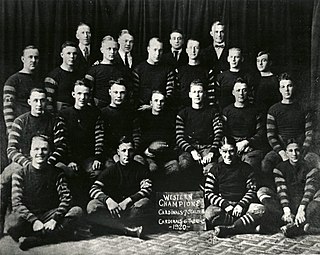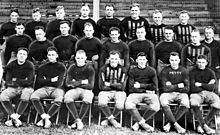Buffalo, New York had a turbulent, early-era National Football League team that operated under multiple names and several different owners between the 1910s and 1920s. The early NFL-era franchise was variously called the Buffalo All-Stars from 1915 to 1917, Buffalo Niagaras in 1918, the Buffalo Prospects in 1919, Buffalo All-Americans from 1920 to 1923, Buffalo Bisons from 1924 to 1925 and in 1927 and 1929, and the Buffalo Rangers in 1926. The franchise, which was experiencing financial problems in 1928, did not participate in league play that season.

The Rock Island Independents were a professional American football team, based in Rock Island, Illinois, from 1907 to 1926. The Independents were a founding National Football League franchise. They hosted what has been retrospectively designated the first National Football League game on September 26, 1920 at Douglas Park. The Independents were founded in 1907 by Demetrius Clements as an independent football club. Hence, the team was named the "Independents."

George Stanley Halas Sr., nicknamed "Papa Bear" and "Mr. Everything", was an American professional football player, coach, and team owner. He was the founder and owner of the Chicago Bears of the National Football League (NFL), and served as his own head coach on four occasions. He was also lesser-known as a player for the New York Yankees of Major League Baseball (MLB).
Primary Products Ingredients Americas LLC, also formerly known as Tate & Lyle Primary Products, is an American subsidiary of Tate & Lyle PLC that produces a range of starch products for the food, paper and other industries; high fructose corn syrup; crystalline fructose; and other agro-industrial products. The company was incorporated in 1906 as A. E. Staley Manufacturing Company by Augustus Eugene Staley.
The 1920 APFA season was the inaugural season of the American Professional Football Association, renamed the National Football League in 1922. An agreement to form a league was made by four independent teams from Ohio on August 20, 1920, at Ralph Hay's office in Canton, Ohio, with plans to invite owners of more teams for a second meeting on September 17, 1920. The "American Professional Football Conference" (APFC) was made up of Hay's Canton Bulldogs, Akron Pros, the Cleveland Tigers and the Dayton Triangles, who decided on a six-game schedule to play each other at home-and-away, an agreement to respect each other's player contracts, and to take a stand against signing college students whose class had not yet graduated.
The 1921 APFA season was the second season of the American Professional Football Association, which was renamed the National Football League in 1922.

George Edward Trafton was an American professional football player and coach, boxer, boxing manager, and gymnasium proprietor. He was inducted into the Pro Football Hall of Fame in 1964 and was also selected in 1969 as the center on the NFL 1920s All-Decade Team.
The 1921 Chicago Staleys season was their second regular season completed in the young American Professional Football Association. The team improved on their 10–1–2 record from 1920 to a 9–1–1 record under head coach/player George Halas earning them a first-place finish in the team standings and their first league championship. The beginning of the season saw A.E. Staley turn over the team to Halas and Dutch Sternaman, who moved the team to Chicago. The team name was changed from the Decatur Staleys to the Chicago Staleys due to a contract between Staley and Halas. The Staleys were quite dominant, but all of Chicago's games were played at home. Two games were against the Buffalo All-Americans; the first, played on Thanksgiving, was won by Buffalo 7–6, giving the Staleys their only loss of the season.

The 1920 Akron Pros season was the franchise's inaugural season with the American Professional Football Association (APFA) and twelfth total season as a team. The Pros entered the season coming off a 5–5 record in 1919 as the Akron Indians in the Ohio League. The Indians were sold to Art Ranney and Frank Nied, two businessmen, to help achieve a better record and crowd. Several representatives from the Ohio League wanted to form a new professional league; thus, the APFA was created.
The 1920 Buffalo All-Americans season was the franchise's inaugural season with the American Professional Football Association (APFA), an American football league, and fifth total as a team. The All-Americans entered 1920 coming off a 9–1–1 record in 1919 as the Buffalo Prospects in the New York Pro Football League (NYPFL). Several representatives from another professional football league, the Ohio League, wanted to form a new national league, and thus the APFA was created.

The 1920 Chicago Cardinals season was the Cardinals' inaugural season in the American Professional Football Association. The team finished 6–2–1, earning fourth in the league. Their final two games of the season against the Chicago Stayms Foresters were played after the APFA season was officially over and did not count towards the standings.
The 1920 Chicago Tigers season was their sole season in the National Football League. The team finished 2–5–1, tying them for eleventh in the league.
The 1920 Cleveland Tigers season was the franchise's inaugural season in the American Professional Football Association (APFA) and fifth total as an American football team. The Tigers entered the season coming off a 5-win, 2-loss, 2-tie (5–2–2) record in 1919. After the 1919 season, several representatives from the Ohio League, a loose organization of professional football teams, wanted to form a new professional league; thus, the APFA was created.
The 1920 Dayton Triangles season was the franchise's inaugural season in the American Professional Football Association (AFPA)—later named the National Football League. The Triangles entered the season coming off a 5–2–1 record in 1919 in the Ohio League. After the 1919 season, several representatives from the Ohio League wanted to form a new professional league; thus, the APFA was created. A majority of the team stayed from the 1919 team, including the coaching staff, while two players left the team.
The 1920 Hammond Pros season was the franchise's inaugural season in the American Professional Football Association (APFA) and second as an American football team. The Pros entered 1920 coming off a 4-win, 2-loss, 3-tie (4–2–3) record in 1919 as an independent team. Several representatives from another professional football league, the Ohio League, wanted to form a new national league, and thus the APFA was created.
The 1920 Muncie Flyers season was the franchise's inaugural season in the American Professional Football League (APFA)—later named the National Football League. The Flyers entered the season coming off a 4–1–1 record in 1919. Several representatives from the Ohio League wanted to form a new professional league; thus, the APFA was created. The 1920 team only played in one game that counted in the standings: a 45–0 loss against the Rock Island Independents. This game and the Columbus Panhandles–Dayton Triangles on the same date is considered to be the first league game featuring two APFA teams. The Flyers tried to schedule other games, but the opponents canceled to play better teams. As a result, the Flyers had to play the rest of the season's game versus local teams. In week 10, the Flyers won a game against the Muncie Offers More AC for the Muncie City Championship. No players from the 1920 Muncie Flyers were listed on the 1920 All-Pro Team, and no player has been enshrined in the Pro Football Hall of Fame.
The 1920 Rochester Jeffersons season was the franchise's inaugural season in the American Professional Football Association (APFA) and thirteenth as an American football team. The Jeffersons entered 1920 coming off a six-win, two-loss, two-tie (6–2–2) record in the New York Pro Football League (NYPFL) where it lost the championship game to the Buffalo Prospects. Several representatives from another professional football league, the Ohio League, wanted to form a new national league, and thus the APFA was created.
The 1920 Rock Island Independents season was the American football franchise's thirteenth season and inaugural season in the American Professional Football Association (APFA). The Independents hosted first ever APFA/National Football League contest on September 26, 1920. After the AFPA had been formed on September 17, 1920, Douglas Park was the venue as the Independents hosted the St. Paul Ideals, winning 48-0 in the new league's first contest.

Walter Harrison Flanigan was an American football player and owner of the Rock Island Independents. He was also one of the co-founders of the National Football League (NFL).

Douglas Park is a public park located at 18th Avenue and 10th Street in Rock Island, Illinois.







